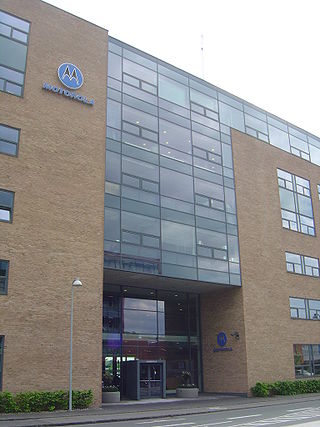
Motorola, Inc. was an American multinational telecommunications company based in Schaumburg, Illinois. It was founded in 1928 as Galvin Manufacturing Corporation by brothers Paul and Joseph Galvin. The company changed its name to Motorola in 1947. After having lost $4.3 billion from 2007 to 2009, the company split into two independent public companies, Motorola Mobility and Motorola Solutions, on January 4, 2011. The reorganization was structured with Motorola Solutions legally succeeding Motorola, Inc., and Motorola Mobility being spun off.
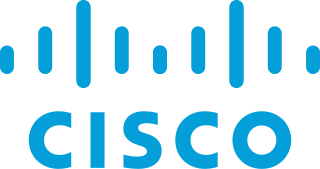
Cisco Systems, Inc., commonly known as Cisco, is an American-based multinational digital communications technology conglomerate corporation headquartered in San Jose, California. Cisco develops, manufactures, and sells networking hardware, software, telecommunications equipment and other high-technology services and products. Cisco specializes in specific tech markets, such as the Internet of Things (IoT), domain security, videoconferencing, and energy management with leading products including Webex, OpenDNS, Jabber, Duo Security, and Jasper. Cisco is one of the largest technology companies in the world ranking 74 on the Fortune 100 with over $51 billion in revenue and nearly 80,000 employees.
National Semiconductor was an American semiconductor manufacturer which specialized in analog devices and subsystems, formerly with headquarters in Santa Clara, California. The company produced power management integrated circuits, display drivers, audio and operational amplifiers, communication interface products and data conversion solutions. National's key markets included wireless handsets, displays and a variety of broad electronics markets, including medical, automotive, industrial and test and measurement applications.

Tandberg was an electronics manufacturer located in Oslo, Norway and New York City, United States. The company began in the radio field, but became more widely known for their reel-to-reel tape recorders as well as cassette decks and televisions. The original company went bankrupt in 1978, after a sharp financial downturn. The following year, the company re-formed whilst their data division was split off as Tandberg Data, including the tape recording division, which reduced its scope to data recording.
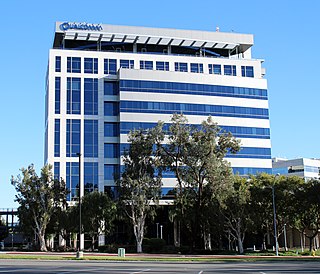
Qualcomm is an American multinational corporation headquartered in San Diego, California, and incorporated in Delaware. It creates semiconductors, software, and services related to wireless technology. It owns patents critical to the 5G, 4G, CDMA2000, TD-SCDMA and WCDMA mobile communications standards.
Gilbert Frank Amelio is an American technology executive. Amelio worked at Bell Labs, Fairchild Semiconductor, and the semiconductor division of Rockwell International, and was also the CEO of National Semiconductor and Apple Computer.
Linksys Holdings, Inc., is an American brand of data networking hardware products mainly sold to home users and small businesses. It was founded in 1988 by the couple Victor and Janie Tsao, both Taiwanese immigrants to the United States. Linksys products include Wi-Fi routers, mesh Wi-Fi systems, Wifi extenders, access points, network switches, and Wi-Fi networking. It is headquartered in Irvine, California.

Juniper Networks, Inc. is an American multinational corporation headquartered in Sunnyvale, California. The company develops and markets networking products, including routers, switches, network management software, network security products, and software-defined networking technology.
Fabless manufacturing is the design and sale of hardware devices and semiconductor chips while outsourcing their fabrication to a specialized manufacturer called a semiconductor foundry. These foundries are typically, but not exclusively, located in the United States, China, and Taiwan. Fabless companies can benefit from lower capital costs while concentrating their research and development resources on the end market. Some fabless companies and pure play foundries may offer integrated-circuit design services to third parties.
Synaptics is a publicly owned San Jose, California-based developer of human interface (HMI) hardware and software, including touchpads for computer laptops; touch, display driver, and fingerprint biometrics technology for smartphones; and touch, video and far-field voice technology for smart home devices and automotives. Synaptics sells its products to original equipment manufacturers (OEMs) and display manufacturers.
Ellen Mooney Hancock was a technology manager from the United States who worked for IBM and Apple, among others.
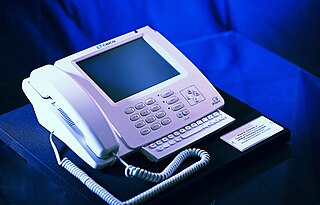
The Linksys iPhone was a line of internet appliances from Cisco Systems. The first iPhone model – released by Infogear in 1998 – combined the features of a regular phone and a web terminal. The company was later purchased by Cisco and no new products were marketed under the name between 2001 and 2006. At the end of 2006, Cisco rebranded its Linksys VoIP-based phones under the name, shortly before Apple released an iPhone of its own. This led to a trademark dispute between the two companies, which was resolved on February 20, 2007.
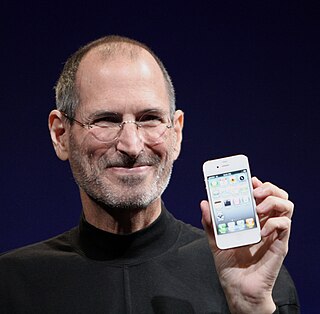
The history of the iPhone development by Apple Inc. spans from the early 2000s to about 2010. The first iPhone was released in 2007. By the end of 2009, iPhone models had been released in all major markets.

Mark D. Papermaster is an American business executive currently serving as the chief technology officer (CTO) and executive vice president for Technology and Engineering at Advanced Micro Devices (AMD). On January 25, 2019 he was promoted to AMD's Executive Vice President. Papermaster previously worked at IBM from 1982 to 2008, where he was closely involved in the development of PowerPC technology and served two years as vice president of IBM's blade server division. Papermaster's decision to move from IBM to Apple Inc. in 2008 became central to a court case considering the validity and scope of an employee non-compete clause in the technology industry. He became senior vice president of devices hardware engineering at Apple in 2009, with oversight for devices such as the iPhone. In 2010 he left Apple and joined Cisco Systems as a VP of the company's silicon engineering development. Papermaster joined AMD on October 24, 2011, assuming oversight for all of AMD's technology teams and the creation of all of AMD's products, and AMD's corporate technical direction.

Imagination Technologies Limited is a British semiconductor and software design company owned by Canyon Bridge Capital Partners, a private equity fund based in Beijing that is ultimately owned by the Chinese government. With its global headquarters in Hertfordshire in the United Kingdom, its primary business is in the design of PowerVR mobile graphics processors (GPUs), neural network accelerators for AI processing, and networking routers. The company was listed on the London Stock Exchange until it was acquired in November 2017 by Canyon Bridge.

Arm is a British semiconductor and software design company based in Cambridge, England. Its primary business is in the design of ARM processors (CPUs). It also designs other chips, provides software development tools under the DS-5, RealView and Keil brands, and provides systems and platforms, system-on-a-chip (SoC) infrastructure and software. As a "holding" company, it also holds shares of other companies. Since 2016, it has been owned by Japanese conglomerate SoftBank Group.
Daniel "Dan" William Dobberpuhl was an electrical engineer in the United States who led several teams of microprocessor designers.

NetLogic Microsystems, Inc. was a fabless semiconductor company that developed high performance products for data center, enterprise, wireless and wireline infrastructure networks. The company was founded in 1995 by Norman Godinho and Varad Srinivasan, became a public company on the NASDAQ exchange under the leadership of CEO Ronald Jankov in July 2004 and was acquired by Broadcom Corporation for $3.7 billion in February 2012.
The following outline of Apple Inc. is a topical guide to the products, history, retail stores, corporate acquisitions, and personnel under the purview of the American multinational corporation Apple Inc.

Digital Ocean, Inc., was a maker of wireless products from 1992 to 1998.













